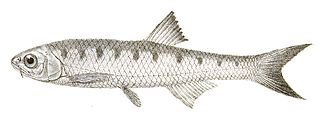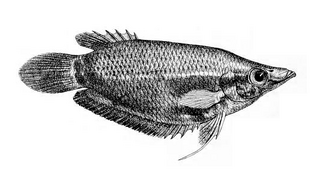
Epalzeorhynchos is a small ray-finned fish genus of the family Cyprinidae. Its members are – like some other cyprinids – known as "freshwater sharks" or simply "sharks". They are, however, freshwater members of the Osteichthyes lineage which is distinct from the Chondrichthyes lineage of sharks. The description of these animals as "shark" is most likely a reference to the shark-like shape of these popular cyprinids.

Ataran River is a river of Burma and Thailand. In Thailand, it is usually known as the Kasat River. It merges into the larger Gyaing River and Salween River near the city of Mawlamyine. A main tributary of the Ataran River is the Zami River. The Ataran and its tributaries begin near the Thai-Burmese border and flow in a general north-north-west direction.

Barilius is a large genus of cyprinid freshwater fishes native to Asia. Four species in this genus have been described since 2012.

The Barna baril is a fish in genus Opsarius of the family Cyprinidae. It is found in India, Nepal, Bangladesh and Myanmar.

Barilius bendelisis is a fish in genus Barilius of the family Cyprinidae. It is found in Pakistan, India, Nepal, Bangladesh, Sri Lanka, Bhutan and Myanmar.

Opsarius bernatziki is a fish in the Opsarius genus of the family Cyprinidae. It is found in Thailand, Southeast Myanmar, and the Malay Peninsula. It is associated with a freshwater habitat and can grow up to 9.1 cm.
Barilius chatricensis is a fish in genus Barilius of the family Cyprinidae. It is found in India.
Barilius caudiocellatus is a fish in genus Barilius of the family Cyprinidae. It is found in China.
Barilius dimorphicus is a fish in genus Barilius of the family Cyprinidae. It is found in India.
Opsarius koratensis is a fish in genus Opsarius of the family Cyprinidae. It is found in the Mekong and Chao Phraya basins and can reach 10 cm (3.9 in) SL.
Barilius ornatus is a fish in genus Barilius of the family Cyprinidae.

Barilius vagra is a fish in genus Barilius of the family Cyprinidae.

Opsarius tileo is a fish in genus Opsarius of the family Cyprinidae which is found in India, Bangladesh and Nepal, and probably Myanmar.

Barilius shacra is a fish in genus Barilius of the family Cyprinidae.
Opsarius cocsa is a species of cyprinid fish endemic to India.

The frail gourami or noble gourami is a mouth brooding species of gourami native to northeastern India and Bangladesh. This species grows to a length of 10 cm (3.9 in). It is only seldom found in the aquarium trade, courtesy of its extreme sensitivity to shipping stress and high levels of aggression. This species is the only known member of its genus.

Opsarius pulchellus, is a species of fish in the family Cyprinidae, with the largest individual recorded being 11 cm long.
Barilius ardens is a fish in genus Barilius of the family Cyprinidae. It is found in Sita and Swarna River systems in the Western Ghats of India.
Barilius bonarensis is a fish in genus Barilius of the family Cyprinidae. It is found in the western Himalaya in India.
Opsarius barnoides is a fish in genus Opsarius of the family Cyprinidae. It is found in Myanmar and China.











